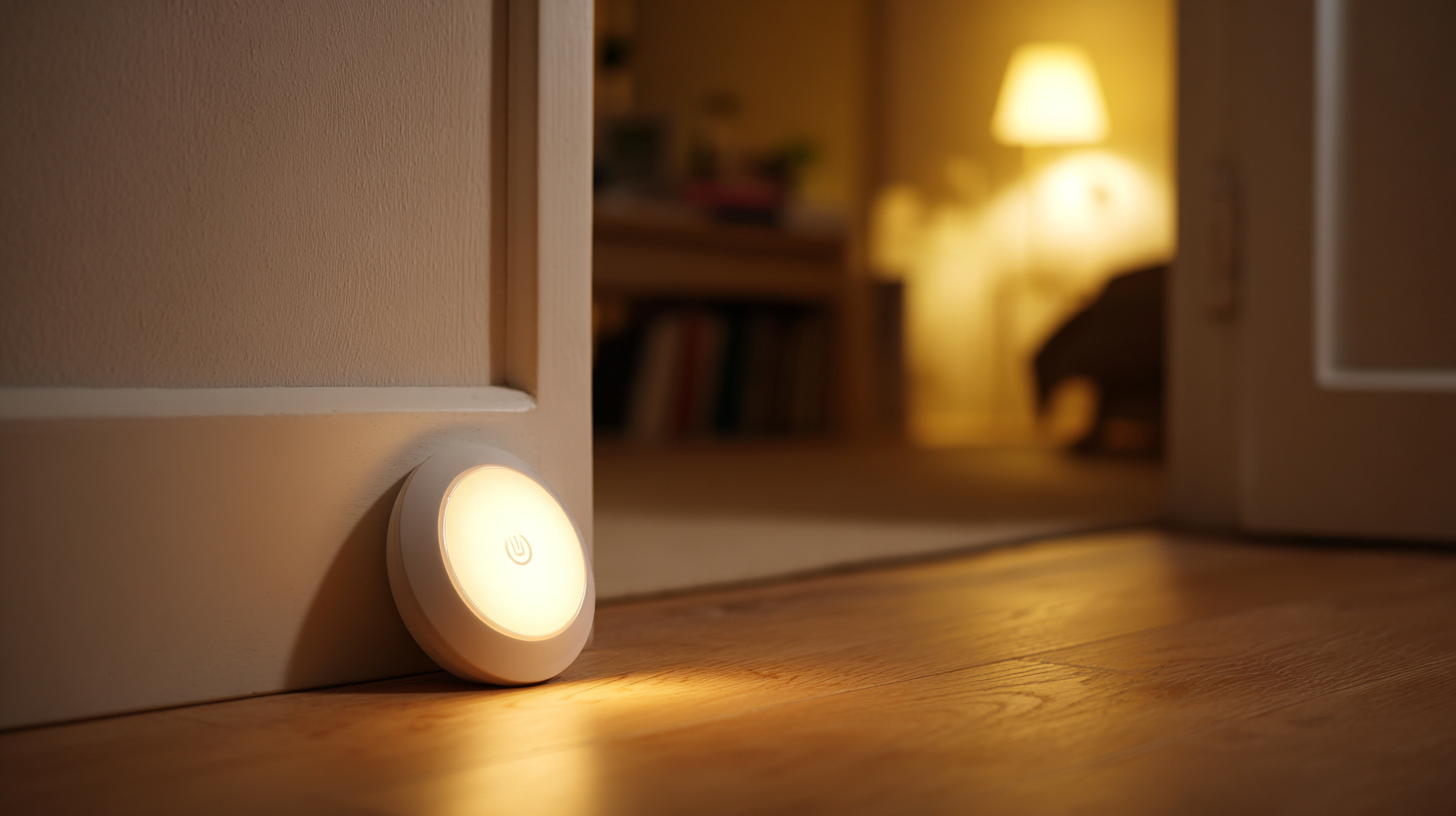Discover the Future of Home Safety with Sensor LED Lights: The Ultimate Guide to Smart Illumination
 As the demand for enhanced home safety solutions continues to rise, the integration of technology into everyday living environments has never been more critical. According to a recent report by MarketsandMarkets, the smart lighting market is projected to reach $30.4 billion by 2024, with sensor LED lights playing a pivotal role in this transition. These innovative lighting systems not only provide illumination but also offer security features that help homeowners monitor their surroundings effectively. By utilizing motion sensors and advanced illumination techniques, Sensor LED Lights can significantly reduce accidents and enhance peace of mind, particularly in high-risk areas such as stairways and entry points.
As the demand for enhanced home safety solutions continues to rise, the integration of technology into everyday living environments has never been more critical. According to a recent report by MarketsandMarkets, the smart lighting market is projected to reach $30.4 billion by 2024, with sensor LED lights playing a pivotal role in this transition. These innovative lighting systems not only provide illumination but also offer security features that help homeowners monitor their surroundings effectively. By utilizing motion sensors and advanced illumination techniques, Sensor LED Lights can significantly reduce accidents and enhance peace of mind, particularly in high-risk areas such as stairways and entry points.
This guide explores the transformative potential of sensor LED lights, underscoring their importance in the modern home safety landscape and demonstrating how they can effectively safeguard our living spaces while contributing to energy efficiency.
Understanding Sensor LED Lights: Technology Behind Smart Illumination
 Sensor LED lights represent a significant advancement in home safety technology, merging illumination with intelligent features designed to respond to their environment.
These lights typically utilize passive infrared (PIR) sensors to detect motion. When someone enters a room or approaches an area, the sensor activates the LED light, providing immediate illumination.
This not only enhances visibility during the night but also acts as a deterrent to potential intruders, making homes safer.
Sensor LED lights represent a significant advancement in home safety technology, merging illumination with intelligent features designed to respond to their environment.
These lights typically utilize passive infrared (PIR) sensors to detect motion. When someone enters a room or approaches an area, the sensor activates the LED light, providing immediate illumination.
This not only enhances visibility during the night but also acts as a deterrent to potential intruders, making homes safer.
Furthermore, many sensor LED lights offer adaptability by allowing users to adjust sensitivity and timing settings. This customization ensures that the lights can operate effectively
in various environments, from dimly lit hallways to outdoor pathways. The integration of smart technology can also enable these lights to connect with home automation systems, allowing users to control
lighting through smartphones or voice commands. Such advancements not only simplify everyday life but also contribute significantly to energy efficiency,
as the lights remain off when no motion is detected, thereby reducing electricity consumption.
The Benefits of Using Sensor LED Lights for Home Safety
Sensor LED lights have revolutionized home safety, offering smart illumination solutions that enhance security and convenience. According to a report by the National Institute of Justice, over 70% of household burglaries occur at night, highlighting the critical need for effective outdoor lighting. The installation of sensor LED lights can deter potential intruders, as the sudden activation of bright lights can startle them and draw attention to their presence.
Moreover, sensor LED lights provide practical benefits beyond mere security. They are energy-efficient, consuming up to 80% less energy than traditional incandescent bulbs, according to the U.S. Department of Energy. This efficiency not only lowers electricity bills but also contributes to reducing the carbon footprint. Families can enjoy the peace of mind that comes with enhanced visibility around their property while knowing they are making a sustainable choice.
Tips: When installing sensor LED lights, place them at entry points such as doors, garages, and walkways to maximize safety. Consider adjusting the sensitivity settings to avoid false alarms caused by pets or passing cars. Additionally, integrating these lights with smart home systems can provide remote monitoring and control, further enhancing your home's security features.
Key Features to Look for in Smart Illumination Solutions
When exploring smart illumination solutions for home safety, certain key features can significantly enhance their effectiveness. Firstly, motion sensing technology is essential; it allows lights to automatically activate upon detecting movement, which can deter intruders and provide safety during nighttime navigation. Combined with adjustable brightness settings, these lights can offer optimal lighting without being overly intrusive, thus allowing homeowners to customize their environment according to their preferences.
Another critical aspect is connectivity. Smart LED lights that integrate with home automation systems can be controlled remotely via mobile applications. This feature enables homeowners to set schedules, adjust lighting from anywhere, and receive notifications related to home security. Additionally, compatibility with voice-activated assistants can further streamline control, making it simpler to manage your home’s lighting with just voice commands. Other features, such as energy efficiency and the ability to change colors, can enhance not only safety but also the overall ambiance of your living space, making smart illumination a vital investment for modern households.

A Comprehensive Guide to Installing Sensor LED Lights Effectively
Installing sensor LED lights can significantly enhance home safety and energy efficiency. According to a report by the U.S. Department of Energy, LED lighting can save homeowners up to 75% more energy than traditional incandescent bulbs, which means that not only can you improve security but also reduce utility bills considerably. However, effective installation is crucial to maximizing these benefits.
When installing sensor LED lights, it's important to identify the high-traffic areas around your home, such as entryways and garages. Position the sensors at a height of 6 to 8 feet to ensure optimal detection, as noted by the International Association of Lighting Designers. Furthermore, many advanced models can be adjusted for sensitivity and duration, allowing the light to activate in low ambient light conditions. This functionality not only deters intruders but also provides peace of mind as you navigate your home during the night. Regular maintenance and placement adjustments based on seasonal changes can further enhance the performance of these smart illumination systems.
Exploring Future Trends in Home Safety Technology with Smart Lighting
The future of home safety technology is set to revolutionize our living environments, with smart lighting emerging as a leading trend. By 2033, the value of smart home safety services is projected to reach an impressive $399.42 million, reflecting a steady compound annual growth rate of 5.8%. This growth signifies a growing recognition of the importance of home safety and the role smart lighting plays within it. Enhanced sensor LED lights not only illuminate spaces but also serve as critical components in home security, offering real-time alerts and automated responses to ensure safety.
Moreover, the evolution of smart home technologies is increasingly linked to our sense of well-being and happiness. The industry has seen leading brands embracing a holistic approach by integrating aesthetic considerations with functional advancements. As manufacturers refine their strategies and explore innovative designs, smart lighting systems are becoming versatile, combining security features with appealing aesthetics. This transformation is not just about illumination; it's about creating a comfortable and secure living environment that resonates with the values of modern homeowners. The interplay of smart devices within our homes is paving the way for safer, more connected living experiences, heralding a brighter future for home safety.
Related Posts
-

Unlocking Energy Savings: How LED Lighting Solutions Transform Your Home and Business
-

Unveiling the Best Led Lamp Display A Comprehensive Comparison of Efficiency and Performance
-

Exploring the Key Specifications of Smart LED Lightstrips: A Comprehensive Installation Guide for Global Buyers
-

Transform Your Space: The Ultimate Guide to Innovative LED Lighting Solutions
-

Creative Uses of Led Lighting in Various Industries
-

What are the Benefits of Smart Led Light Fixtures in Modern Spaces
